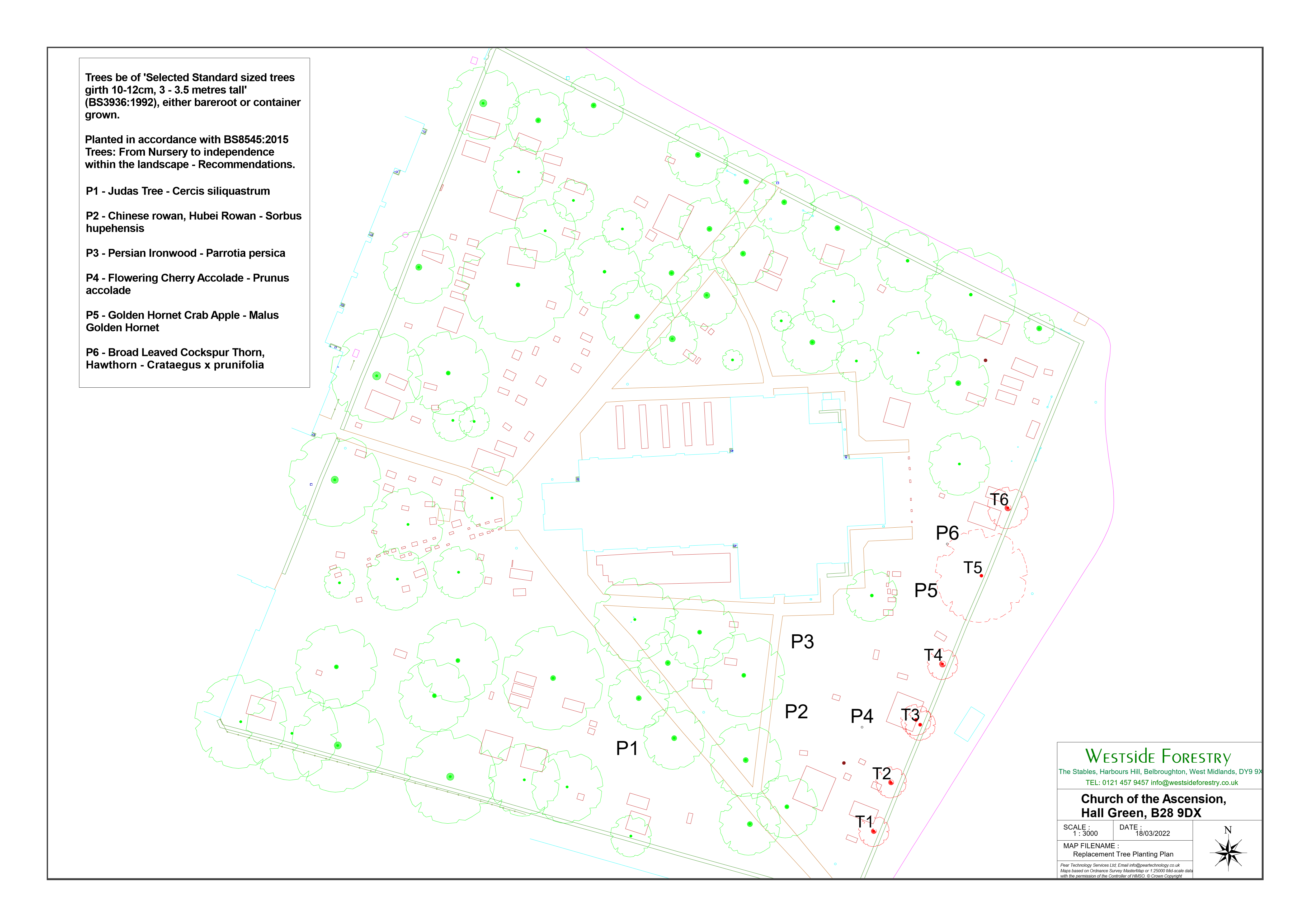CHURCH OF THE ASCENSION, HALL GREEN - REPLACEMENT TREE PLANTING

The Lime and Holly trees (numbered with T1 – T6 indicated on the attached plan), are to be removed in order make safe and repair the boundary wall and replacement tree planting is required to mitigate the loss of those trees. The following considerations have been made with respect to proposed replacement tree planting species selection:
· Tree species which will improve species diversity of the site to add resilience of the treescape of the site.
· Trees with limited potential to cause future problems associated with root, size and
maintenance requirements.
· Trees which have attributes which will improve the visual amenity of the locality (such as flower, autumn colour, fruit etc).
· Trees which have potential to provide wildlife habitat.
The proposed planting locations are indicated on the attached Replacement Tree Planting Plan (P1 – P6). The locations have been selected to minimise potential conflict with existing features, however, should excavation during planting reveal any such features, then actual planting locations will be altered to the nearest appropriate location.
Trees will be of ‘Selected Standard sized trees girth 10-12cm, 3 – 3.5 metres tall (BS3936:1992) and planted in accordance with BS8545:2015 Trees: From Nursery to independence within the landscape Recommendations. Trees will be planted during the planting season (November – March) and be suitably maintained.
The following trees have been selected:
Judas Tree - Cercis siliquastrum
Judas Tree is an interesting tree, which produces its bloom straight from the trunk and stems of the tree
Commonly known as the Judas tree, this tree was introduced to England in the 16th Century. The rosy-lilac, pea-like flowers cover the wood in May, producing a stunning floral display. Following the flowers, the bright green, almost heart shaped leaves are developed, later accompanied by dark purple tinted seed pods in July.
Mature height: 3-7m

Chinese Rowan, - Sorbus hupehensis

Discovered by Ernest Wilson and introduced from its native western China in 1910, this lovely rowan stands out by its flat blue tinged leaves and light brown trunk.
It forms a compact broadly oval crown at maturity. Splendid white berries start out pink before turning white, they are produced in large clusters with stunning red autumn colour.
A small, low maintenance tree which thrives on most soils and can tolerate the rigours of the urban environment.
Being white, the berries are the last to be taken by birds, so can remain on the tree way past Christmas.
Mature height: 3-7m
Persian Ironwood - Parrotia persica
This tree has large round leaves which are thick and slightly heart shaped, it is most notable for its fantastic display of autumn colour which ranges from crimson, to red, to yellow, to orange and golden.
The dark red flowers are displayed on the bare stem during the wintertime.
The bark becomes more and more mottled yellow as the tree matures, being grey-brown when the tree is young.
Parrotia persica is native to Iran.
It is a reliable tree which will thrive on most soils, including chalk.
Mature height: 3-7m

Flowering Cherry Accolade - Prunus accolade

Prunus Accolade is a hybrid cross between Prunus sargentii and Prunus x subhirtella.
This tree is one of the first Ornamental Cherry trees to come into flower in the springtime, producing its prolific semi-double pink flowers very early in spring. It can sometimes produce a few flowers over the wintertime too, however, tends to give its most reliable display in spring.
Following the floral display, the leaves emerge, dark green and relatively small for a Cherry. In autumn. The tree provides an attractive orange-red autumn display.
This Ornamental Cherry tree is a superb performer; it is tolerant of most soils that are well drained, including calcareous ones.
At maturity this tree develops a rounded, spreading habit and forms a tree of medium size.
Mature Height 7-12m
Golden Hornet Crab Apple - Malus Golden Hornet
Malus Golden Hornet is a superb Crab Apple which has been available since the 1940’s.
This pretty tree produces a profuse display of pure white flowers in the springtime. The green leaves emerge shortly afterwards and provide almost full coverage by the time the floral display is over.
The plump fruits develop towards the end of the summer, initially small and green, the fruits gradually ripen to be a striking Golden Yellow colour.
Malus Golden Hornet forms an oval headed, small, tree at maturity. It is a tough performer and like all Crab Apple trees will tolerate a range of soil conditions, including clay. The vivid yellow of the fruit really is quite striking and will provide interest for months after the summer is over.
Mature Height: 3-7m

Broad Leaved Cockspur Thorn, Hawthorn - Crataegus x prunifolia

Crataegus x prunifolia, known as Broad Leaved Cockspur Thorn, makes a magnificent small garden tree with a rounded habit at maturity.
White flower in the spring gives way to red hips by autumn so this tree is a popular choice for bird lovers. The green summer foliage turns a vivid yellow through to red in the autumn before leaf fall.
Originating from eastern America, this tough hardy tree thrives on most soils.
Mature Height: 3-7m

